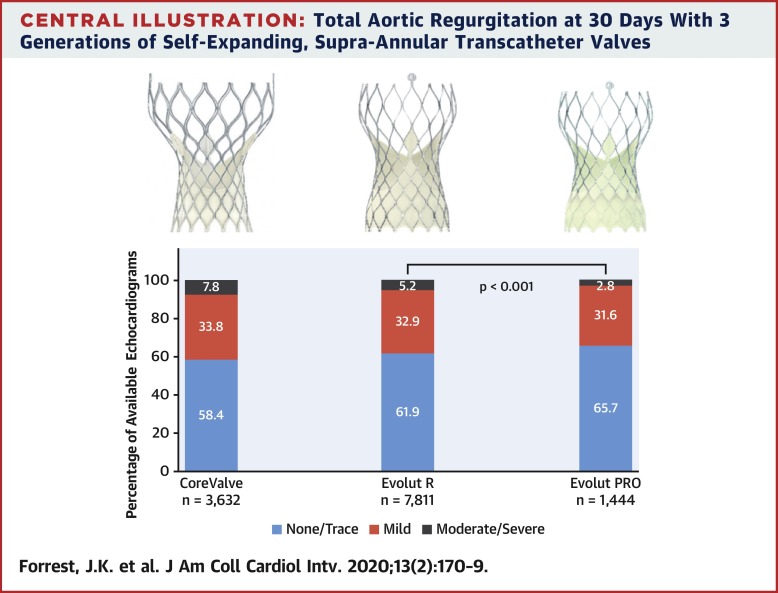当前位置:
X-MOL 学术
›
JACC Cardiovasc. Inte.
›
论文详情
Our official English website, www.x-mol.net, welcomes your feedback! (Note: you will need to create a separate account there.)
Three Generations of Self-Expanding Transcatheter Aortic Valves: A Report From the STS/ACC TVT Registry.
JACC: Cardiovascular Interventions ( IF 11.3 ) Pub Date : 2020-01-27 , DOI: 10.1016/j.jcin.2019.08.035 John K Forrest 1 , Ryan K Kaple 1 , Gilbert H L Tang 2 , Steven J Yakubov 3 , Tamim M Nazif 4 , Mathew R Williams 5 , Angie Zhang 6 , Jeffrey J Popma 7 , Michael J Reardon 8
JACC: Cardiovascular Interventions ( IF 11.3 ) Pub Date : 2020-01-27 , DOI: 10.1016/j.jcin.2019.08.035 John K Forrest 1 , Ryan K Kaple 1 , Gilbert H L Tang 2 , Steven J Yakubov 3 , Tamim M Nazif 4 , Mathew R Williams 5 , Angie Zhang 6 , Jeffrey J Popma 7 , Michael J Reardon 8
Affiliation

|
OBJECTIVES
The aim of this study was to assess the evolution of early outcomes for 3 iterative self-expanding transcatheter aortic valves.
BACKGROUND
Over the past decade there have been rapid advancements in transcatheter aortic valve replacement (TAVR) technologies, including 3 generations of supra-annular self-expanding transcatheter systems.
METHODS
Data from the Society of Thoracic Surgeons/American College of Cardiology TVT (Transcatheter Valve Therapy) Registry for patients undergoing TAVR with CoreValve, Evolut R, or Evolut PRO valves to treat tricuspid aortic stenosis between January 2014 and September 2017 were obtained. Patient risk and echocardiographic data are site reported. Valves analyzed included 23-, 26-, and 29-mm sizes to fit 18- to 26-mm annular diameters. Propensity score matching was performed using the Evolut PRO group as the common reference.
RESULTS
Of 18,874 patients undergoing TAVR at 381 centers, 5,514 patients were implanted with CoreValve, 11,295 with Evolut R, and 2,065 with Evolut PRO valves. At 30 days, there were significantly fewer patients with more than mild aortic regurgitation for the unmatched (7.8% CoreValve, 5.2% Evolut R, and 2.8% Evolut PRO; p < 0.001) and matched populations (8.3% CoreValve, 5.4% Evolut R, and 3.4% Evolut PRO; p = 0.032). The mean aortic valve gradients at 30 days in the matched populations were <8 mm Hg for all 3 valves (7.3 mm Hg CoreValve, 7.5 mm Hg Evolut R, 7.2 mm Hg Evolut PRO).
CONCLUSIONS
Advancements in transcatheter valve technologies and expanding indications for TAVR have resulted in improved outcomes for patients undergoing TAVR in the United States with self-expanding, supra-annular valves. In particular, the addition of an outer pericardial tissue wrap designed to enhance sealing at the level of the aortic annulus has resulted in very low rates of significant aortic regurgitation while maintaining excellent hemodynamic status.
中文翻译:

三代自扩张式经导管主动脉瓣:STS / ACC TVT注册中心的报告。
目的本研究的目的是评估3种迭代自扩张式经导管主动脉瓣的早期预后的演变。背景技术在过去的十年中,经导管主动脉瓣置换术(TAVR)技术取得了飞速发展,其中包括3代超瓣膜自扩张导管系统。方法从2014年1月至2017年9月期间,采用CoreValve,Evolut R或Evolut PRO瓣膜行TAVR来治疗三尖瓣主动脉狭窄的患者,从胸外科医师协会/美国心脏病学会TVT(经导管瓣膜治疗)注册中心获得数据。患者风险和超声心动图数据在现场报告。分析的阀门包括23毫米,26毫米和29毫米的尺寸,以适合18到26毫米的环形直径。使用Evolut PRO组作为共同参考进行倾向得分匹配。结果在381个中心接受TAVR的18874例患者中,有5514例患者植入了CoreValve,11 295例使用了Evolut R,而2065例使用了Evolut PRO瓣膜。在第30天,患有不匹配(7.8%CoreValve,5.2%Evolut R和2.8%Evolut PRO; p <0.001)和匹配人群(8.3%CoreValve,5.4%Evolut R)的轻度主动脉瓣反流多于患者,和3.4%Evolut PRO; p = 0.032)。对于所有3个瓣膜(7.3 mm Hg CoreValve,7.5 mm Hg Evolut R,7.2 mm Hg Evolut PRO),在匹配人群中,第30天的平均主动脉瓣梯度均<8 mm Hg。结论经导管瓣膜技术的进步和TAVR适应症的扩大已导致在美国采用自扩张式瓣膜环上瓣膜接受TAVR的患者的预后得到改善。特别是,增加心外膜组织包裹物以增强主动脉瓣环水平的密封性,导致显着的主动脉反流率非常低,同时保持了出色的血液动力学状态。
更新日期:2020-01-21
中文翻译:

三代自扩张式经导管主动脉瓣:STS / ACC TVT注册中心的报告。
目的本研究的目的是评估3种迭代自扩张式经导管主动脉瓣的早期预后的演变。背景技术在过去的十年中,经导管主动脉瓣置换术(TAVR)技术取得了飞速发展,其中包括3代超瓣膜自扩张导管系统。方法从2014年1月至2017年9月期间,采用CoreValve,Evolut R或Evolut PRO瓣膜行TAVR来治疗三尖瓣主动脉狭窄的患者,从胸外科医师协会/美国心脏病学会TVT(经导管瓣膜治疗)注册中心获得数据。患者风险和超声心动图数据在现场报告。分析的阀门包括23毫米,26毫米和29毫米的尺寸,以适合18到26毫米的环形直径。使用Evolut PRO组作为共同参考进行倾向得分匹配。结果在381个中心接受TAVR的18874例患者中,有5514例患者植入了CoreValve,11 295例使用了Evolut R,而2065例使用了Evolut PRO瓣膜。在第30天,患有不匹配(7.8%CoreValve,5.2%Evolut R和2.8%Evolut PRO; p <0.001)和匹配人群(8.3%CoreValve,5.4%Evolut R)的轻度主动脉瓣反流多于患者,和3.4%Evolut PRO; p = 0.032)。对于所有3个瓣膜(7.3 mm Hg CoreValve,7.5 mm Hg Evolut R,7.2 mm Hg Evolut PRO),在匹配人群中,第30天的平均主动脉瓣梯度均<8 mm Hg。结论经导管瓣膜技术的进步和TAVR适应症的扩大已导致在美国采用自扩张式瓣膜环上瓣膜接受TAVR的患者的预后得到改善。特别是,增加心外膜组织包裹物以增强主动脉瓣环水平的密封性,导致显着的主动脉反流率非常低,同时保持了出色的血液动力学状态。



























 京公网安备 11010802027423号
京公网安备 11010802027423号